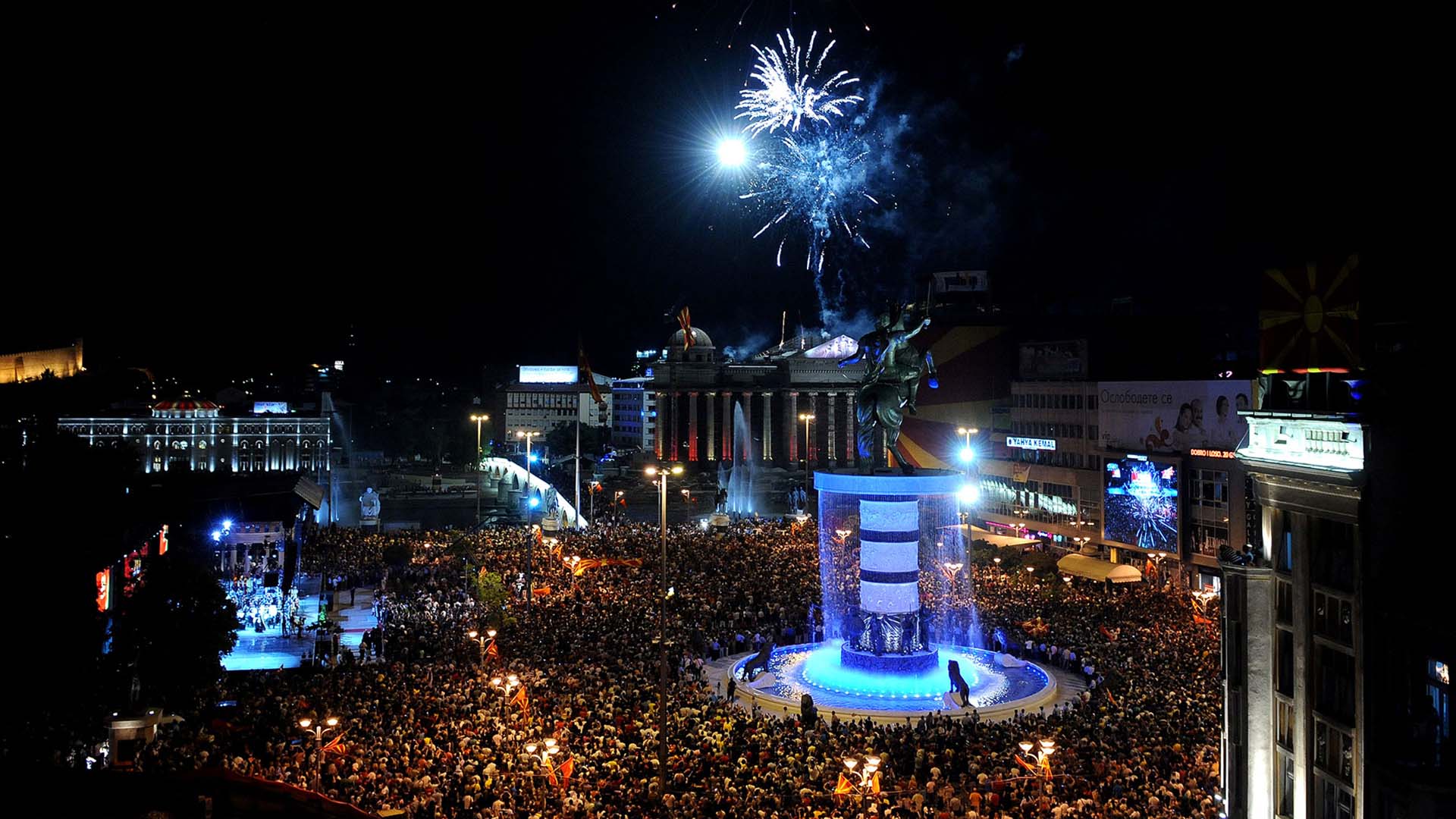Basic information about Skopje
The capital of Macedonia is the city of Skopje. It is the largest city in the country and at the same time it represents an administrative-political, economic, cultural and educational-scientific centre. It is located in the northern part of the country, divided into two parts by the river Vardar. The city in the course of its existence, depending on the historical circumstances, was named by different names, and its ancient name is Skupi.
General data on the City of Skopje
Skopje is a city in the central part of the Balkan Peninsula. It communicates easily with the Mediterranean region to the south and the area of Central and Northern Europe to the north. Through the Kacanicka Ravine it connects with the Adriatic Sea. To the east, through Kumanovo and Kriva Palanka it connects with the Republic of Bulgaria, to the west it connects with Polog, Kicevo valley, the Ohrid-Prespa region and the Republic of Albania.
Skopje dates from the pre-ancient period. This city had a strategic significance in the ancient period, when it was known as Skupi. Excavations from the ancient town of Skupi are located in the area of Zajcev Reid above the mouth of the Lepenec River in Vardar, near today's village of Zlokukani. At that time Skupi was the capital of Dardania.
Skopje’s History
In the Byzantine documents, the city of Skopje was called Skopia, and the Slavs also referred to it as Skopie, Skopje or Skoplje. During the reign of the emperor Samoil, the city belonged to the Samoil's kingdom, while in the later period it was under Byzantine, Bulgarian and Serbian rule. In 1392, the city was captured by the Ottomans and it was named Uskup (Üsküp).
In 1962 due to heavy rains, the river Vardar flooded Skopje. The flood was an indication of the largest earthquake the city experienced. On July 26, 1963, at 5:17 am, the city was devastated by an earthquake measuring 9 degrees on the Mercalli scale (6.1 according to the Richter seismic scale). Due to the earthquake, 1,070 people have lost their lives, 90% of the city buildings have been demolished, and over 20,000 people have been left homeless. After the earthquake, the city began to be built on a model of the designs of Kenzo Tange and Adolf Ciborovski. The old railway station, today is a museum of the city of Skopje and a symbol of the great earthquake. The clock of the station has forever stopped at the fatal 05.17 hrs. in the morning.
Today, Skopje is considered a city of solidarity due to the fact that specifically with solidarity, the city managed to renew itself. The initial assistance to the citizens came from all Yugoslav republics at that period, and a few days after the earthquake aid and rescue crews from all over the world arrived. Exactly 87 nations in the world provided assistance and helped for the city to be built again.
Geographic characteristics
Skopje is located at 21° 26′ geographic longitude and 42° north geographic latitude. The altitude in the centre of the city is 240 m, it extends on an area of 1,818 km2, with 9 km in width and 23 km in length. The city's climate is characterized by an average annual temperature of about 12.4°C. The summers are long, dry and hot, and the winters are cold, with many misty days. The River Vardar flows through the valley of Skopje with its tributaries: Treska, Pchinja, Markova Reka, Lepenec and Kadina Reka. The Skopje valley is surrounded by the mountains: Vodno, Karadzica, Osoj, Zheden and Skopska Crna Gora.
Main features of Skopje
Places of interest for tourist sightseeing tours are:
- The Stone Bridge, on the river Vardar is a symbol of Skopje. It was reconstructed in the 15th century and represents a connection between the new and the old part.
- Fortress Kale - The first walls were built at the beginning of the 6th century. The fortress dominates the left bank of the river Vardar overlooking the old part of the city.
Kale – Fortress of Justinian I
It is thought that the area of the fortress Kale, known as the Skopje Kale, was inhabited as early as in the Neolithic period and early Bronze Age, as witnessed by numerous archaeological findings. The fortress itself dates back to the time of Emperor Justinian I (535). Due to its strategic position and role, the fortress throughout history had often been attacked and used by various warriors. After the collapse of Samoil's empire (1018), the city was captured by the rebels of Peter Deljan (1014-1041). It was then attacked by the Kumanians, the Scythians, the Pecheneses, and so on. Various archaeological remains were found at the Kale. Today the fortress Kale is one of the most remarkable buildings in Skopje with the presence of a number of different cultural and tourist motifs.
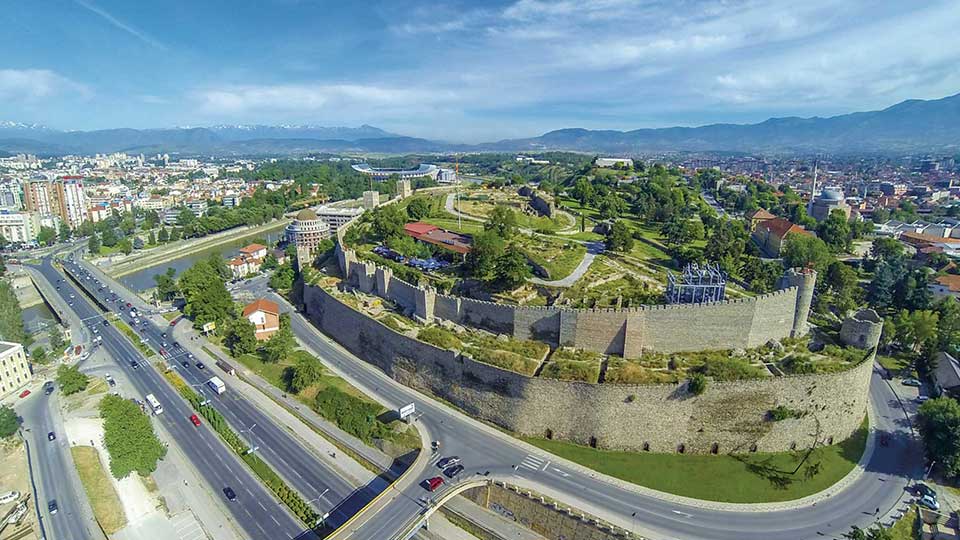
Stone Bridge as a symbol of Skopje from the 15th century
The stone bridge on the river Vardar was built in the first half of the 15th century. The bridge connects the old with the new part of the city. Side walkways were built in 1905, and in the last decade of the 20th century it was completely renovated. On the left side of the river on the bridge there is a memorial plaque of the shot citizens of Skopje in 1944 during the fascist occupation.

In its original form, the bridge had 13 arches, with a total length of 215 metres and a width of six metres. In order to restore the original appearance of the Stone Bridge, in 1992, new interventions started, whereby the initial width of the bridge was achieved.
Church St. Spas in SKopje
The Orthodox Church "St. Spas ", in the old part of the city was built in the XIX century. The iconostasis contains beautiful wooden carvings, carved by the mijak carvers Petre and Marko Filipovski and Makarie Frchkovski. In the courtyard of the church is the tomb of the greatest Macedonian revolutionary of the 20th century - Goce Delcev, and next to it is the Old Turkish Bazaar, where there are old crafts, Bezisten, Chihte-amam and other important facilities.
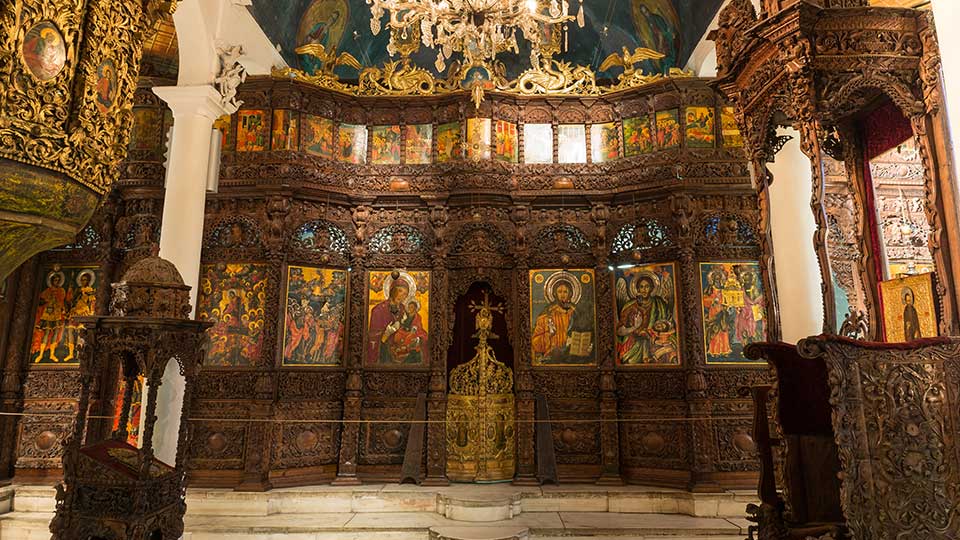
Porta Makedonija (Gate Macedonia)
It was built in 2011 and was put into operation at Christmas 2012. The building has dimensions of 20 to 10 meters and a height of 21 meters. The facade is decorated by 32 reliefs in deep carving with a total area of 193 m2.
The reliefs depict images from the prehistoric period through the pile-dwelling in the Bay of Bones, from the antique with Philip II and Alexander III of Macedonia, from the Roman period to Justinian I, from the Middle Ages with Tsar Samuil, King Marko and Karpos, and until the XX century with Ilinden, ASNOM, the Exodus from Aegean Macedonia and September 8, 1991 - the proclamation of an independent Macedonia.

There are also reliefs of the monastery St. Jovan Bigorski, an Ohrid house, Daut Pasha Amam, the Poetry Bridge in Struga have also been represented. Inside there is a souvenir shop and gallery space on two levels, and at the top an observation platform.
Warrior on a horse
The monument is a composition of several elements. Alexander's bronze monument has a height of 14.5 metres and weighs 30 tons. In the middle of the ten-meter-high pillar is the warrior Alexander II of Macedonia, known as Alexander the Great, looking in the direction of the sunrise. On that pedestal there are three rings with mounted plates, representing three battles. Among them there are three rings of bronze, with decoration and ornamental reliefs. Around the pillar is a fountain complemented by eight bronze soldiers that are three metres tall and eight lions, two and a half metres high, four of which are facing the fountain. The monument is a work of Valentina Karanfilova - Stefanova.
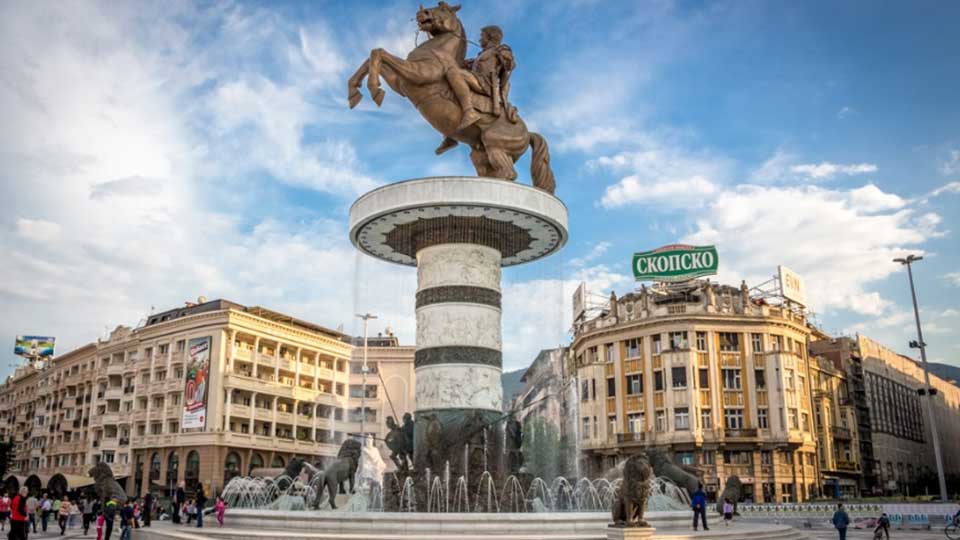
Macedonia Square
Macedonia Square in Skopje was more fully formed in the period between the two world wars, more precisely from 1920 to 1940. It is located in the context of the Stone Bridge, as the basic link of the city units from the left and the right side of Vardar. Important facilities were located around it: the National Bank, the Post Office, Officer's Building, Na-Ma Department Store, Hotel Macedonia, Ristic Palace. However, after the Second World War, and especially after the 1963 disastrous earthquake, part of the buildings were demolished, so that today the square in Skopje has a somewhat different arrangement, but there are still important administrative, cultural, shopping, banking, catering - tourism, and other facilities in its immediate vicinity. In its immediate vicinity is also the Pella Square with the Gate Macedonia, as a real gateway for an entrance to the square.
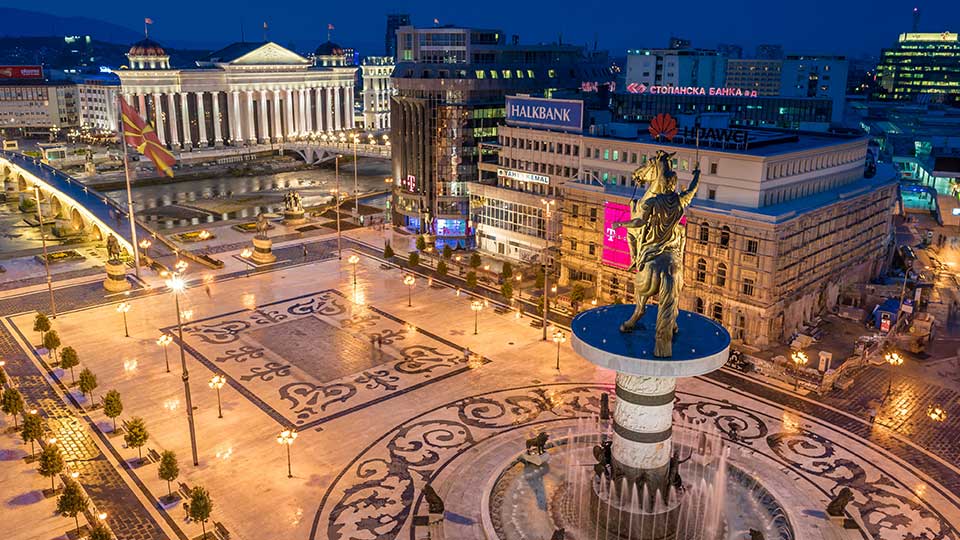
Monuments in the central city area
In the period from 2010 to 2012, Macedonia Square was enriched with several monuments of the famous Macedonian revolutionaries from the time of Ilinden 1903 and ASNOM 1944. Immediately beside the Stone Bridge, the monuments of the Macedonian revolutionaries Goce Delchev and Dame Gruev rise. Opposite them is the monument of the first president of the Presidium of the National Assembly of the People's Republic of Macedonia, Metodija Andonov-Cento. Opposite, and next to the grandiose Warrior on a horse, the five meter marble statue of Tsar Samuil rises, set on a pedestal in the height of 3.5 meters. On the square itself is the monument of Dimitrija Cupovski, and in the park "Zena Borec" opposite the Assembly of the Republic of Macedonia, a memorial - sign of the First Session of ASNOM was placed.
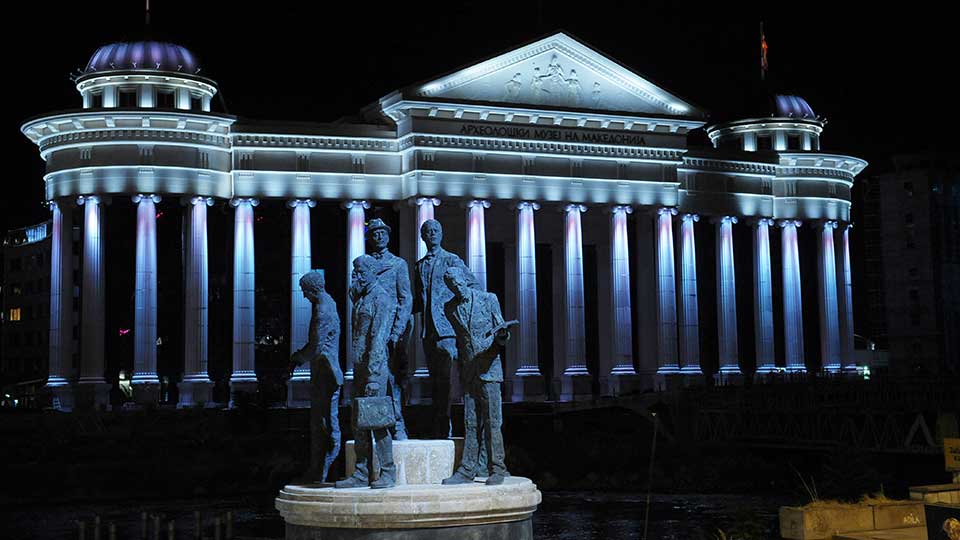
On the quay of Vardar are the monument of Justinian I, five meters high, placed on a pedestal of 3.5 meters. Against him, the figures of the bronze Gemidzii are placed. Near the Stone Bridge on the side of the Old Bazaar, the bronze monuments of the Aidut military duke Peter Karposh and Gjorgjija Pulevski are placed, as well as the monuments of Ss. Cyril and Methodius and Ss. Clement and Naum of Ohrid.
Memorial house of Mother Theresa
The memorial house and the memorial of Mother Teresa (1910 - 1997) are located on the street Macedonia, in the centre of the city of Skopje. It is dedicated to the great humanist Agnesa Gondza Bojadziu - Mother Teresa, born in Skopje, winner of the 1979 Nobel Peace Prize. Today, Mother Teresa’s missionaries of charity include over 3,000 sisters and over 500 brothers in many countries around the world.
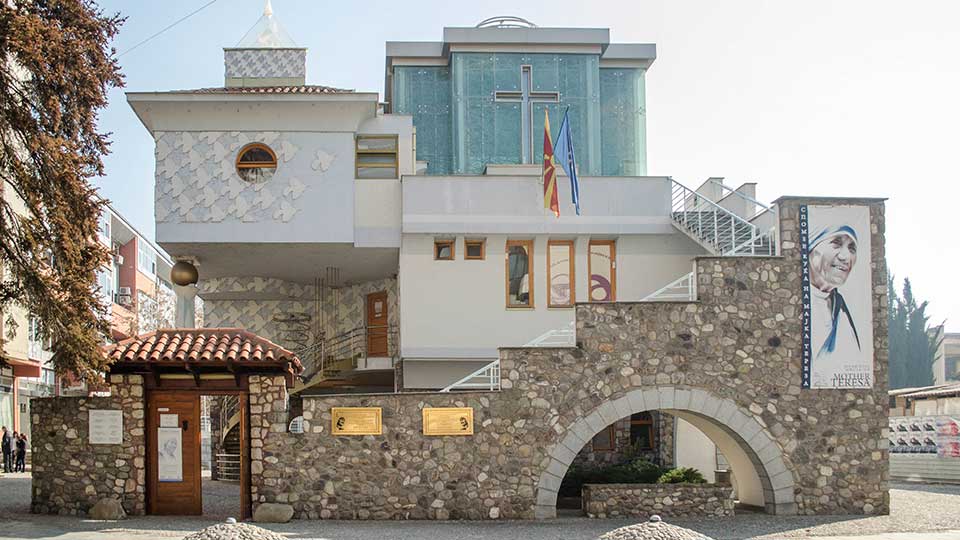
Mother Teresa was proclaimed an honoured citizen of her hometown of Skopje, which from her departure for a humanitarian mission to help the hungry and desolate people she visited four times: in 1970, 1978, 1980 and 1986.
Cathedral St. Kliment Ohridski (Clement of Ohrid)
The cathedral St. Kliment Ohridski is a facility from the recent history of the Macedonian church building. Its construction dates back to the seventies and eighties of the 20th century. It was consecrated in 1990. It is the seat of the Macedonian Orthodox Church - Ohrid Archbishopric. It is located in the centre of Skopje.
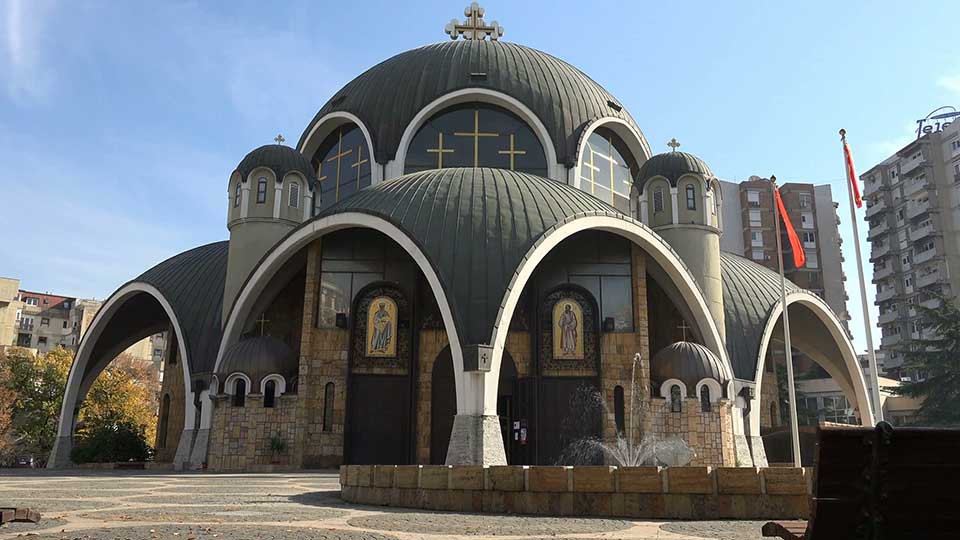
Old Bazaar
In Skopje, on the left side of Vardar, through the Stone Bridge is the Old Skopje Bazaar. Part of the city with diverse and rich history, tradition, culture and architecture, today with a blend between the old and the new, the economy and trade, culture and tradition. In the spirit of the historical temporal and developmental circumstances, the culture of organization and tradition of living, the Old Skopje Bazaar has preserved numerous functional facilities from the Ottoman period, and new buildings have been built as a feature of modern times. These include the Skopje Bezisten, Kapan An, Suli An, Kurshumli An, Daut - Pasha Amam, Cifte Amam, the church St. Spas, the church St. Dimitrij, the complex of museums of Macedonia (historical, archeological, ethnological museum).
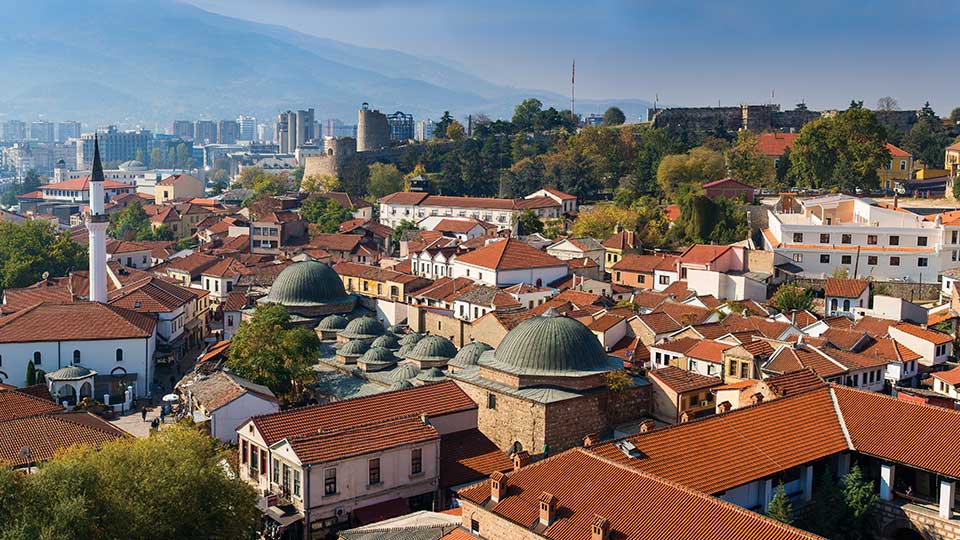
The Old Skopje Bazaar, dating from the 12th century, most actively developing from the 15th to the 19th century, is a complex economic - trade, architectural and cultural - traditional assembly. It was built in oriental style, with several wider and more narrow and cobblestone paved streets. Along them, blinded to each other, there are various craft and trade shops. Here, you can find various traditional crafts, blacksmiths, goldsmiths, potters, shoemakers, tailors, watchmakers, tinsmiths, saddle-makers with various production and service activities. There are also various shops for modern industrial goods and products that can be found only here. The Old Bazaar is complemented by the largest green market in Skopje. The Bazaar is the centre of the most attractive catering shops with a variety of traditional dishes.
Daut - Pasha Amam, an impressive monument of Islamic architecture and art gallery
Daut Pasha Amam is a bath built during the 15th century by the great Vizier of Rumelia. It was probably built by masters of the famous Debar bricklayers’ school. Built in the centre of Skopje, in about hundred metres from the Stone Bridge, the Amam was fully restored in 1948. The most striking part is the roof, composed of 13 unequally distributed domes. Inside there are 15 rooms, different in size, interconnected with vaulted ornaments decorated with oriental ornaments. Besides Cifte Amam and Mala Stanica, today it is part of the National Gallery of Macedonia. Daut Pasha Amam has a collection from the 15th and 16th century, with a rich collection of paintings from the 18th and 19th century, as well as from the contemporary Macedonian painting.
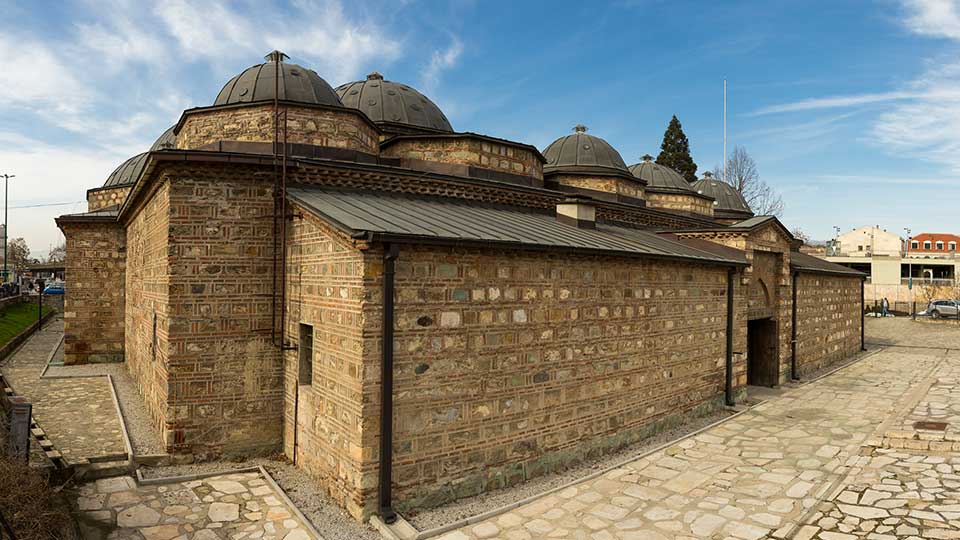
Kurshumli an is a recognizable historical heritage of Skopje
It is assumed that Kurshumli An (lead an) was built in the middle of the 16th century. It consisted of two parts - one for the placement of merchants and goods, and the other included the barn, the auxiliary rooms, and the rooms for the servants. For a long time it served as a gathering place for merchants and their caravans and played an important role in the development of the city's commercial life. It retained the role of a lodging until the end of the 19th century, and then it was converted into a prison. It is believed that it obtained its name during the 19th century, due to the roof that was made of lead. Impressive are the semi-circular walls on the second floor and the fountain in the middle of the an. Today in the an there is a lapidarium of the Archaeological Museum, located in the cells of the ground floor. Each cell contains monuments originating from the same area and from the same period, when Macedonia was a Roman province.
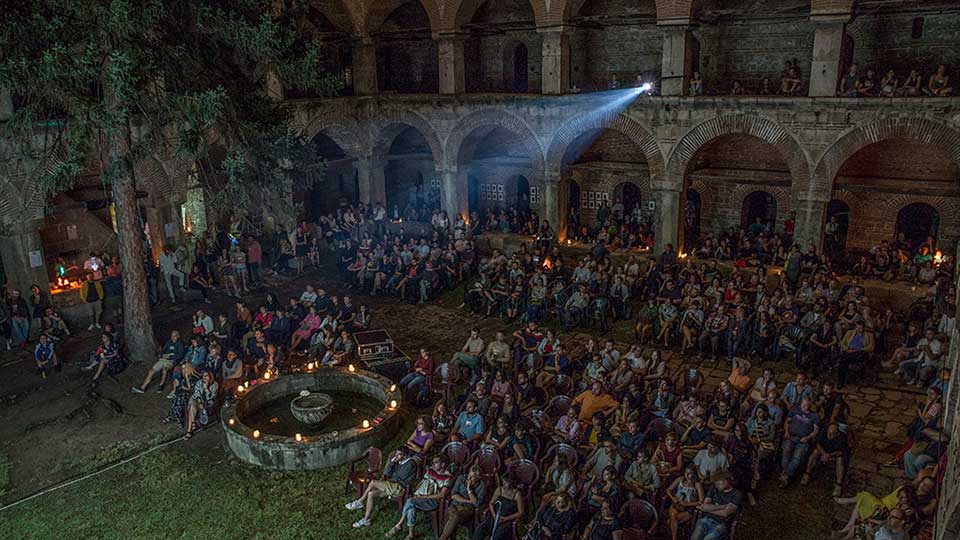
The City Konak Sully An is today a gallery and museum
Suli an is a 15th century building, built by Ishak Bey. In the 16th century it was upgraded, so that the upper floors became trade shops. During the earthquake it was severely destroyed, but it was restored acquiring its original appearance. Today it is the seat of the Gallery of Contemporary Art and the Faculty of Arts, and since 1983 the Museum of the Old Skopje Bazaar has also been located there.

Mustafa - Pasha Mosque one of the most magnificent buildings of the Ottoman period of Skopje
The Mustafa - Pasha Mosque was built by the Skopje commander Mustafa Pasha in 1492. It is located opposite the entrance of the Skopje Fortress. The mosque is basically a quarterly architectural pedestal built of marble blocks decorated with various ornaments. The minaret is built of beam blocks. In this mosque is the richly decorated sarcophagus of Uma - the daughter of the builder of the mosque, then the fountain, the remnants of the former imarets, the madrasa, and more. Today it is an important monument of culture and a place for the spiritual confession of members of the Muslim faith.
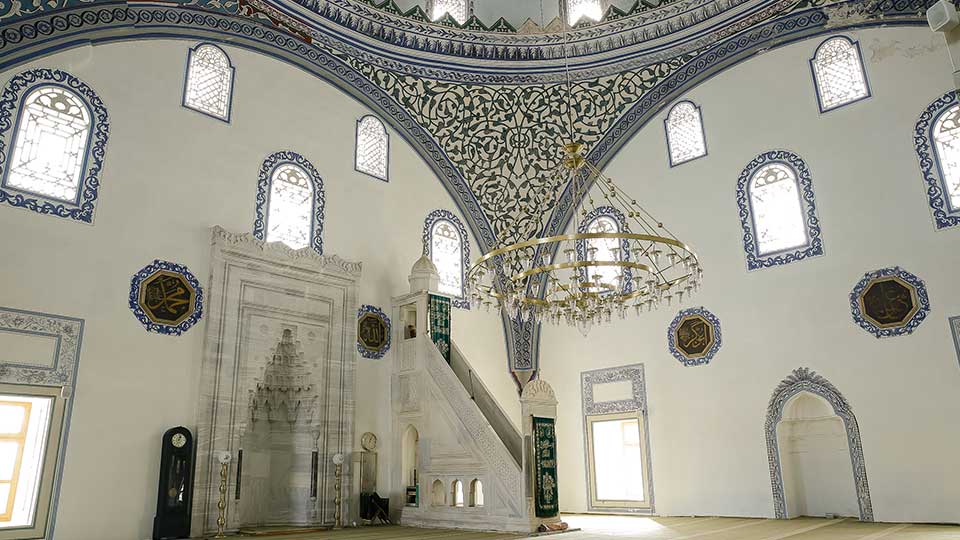
The Clock Tower is the first tower in the Ottoman Empire
The Clock Tower in the Old Skopje Bazaar dates from the middle of the 16th century, more precisely from the period from 1566 to 1572. It is considered to be the first clock tower in the Ottoman Empire, as part of the Sultan Murat’s Mosque. It is 40 meters high and consists of several parts ending with a dome. The clock was lost during the 1963 earthquake in Skopje, when the tower was seriously damaged. Today it attracts noticeable attention with its striking features.

Skender Bey’s Monument
Gjergj Kastriot - Skender Bey (1405-1468) is a national hero from Albania, a fighter for freedom from the Ottoman slavery. As a work of the sculptor Toma Tomai Dema Bekir from Albania, the Skender Bey's monument was set in 2006. Skender Bey is considered a great leader who protected and defended the values of medieval Europe during the Ottoman conquests in the Balkans. The installation of the monument in Skopje is a confirmation of the traditional city spirit of unity.

St. Spas one of the most beautiful Mijak carving works
The church St. Spas was built in the late 17th century and is one of the most important cultural monuments in Skopje. It is located right from the Kale fortress. It seems small and insignificant, but has great importance. Especially valuable is the iconostasis, which was created in a period of five years and was completed in 1824. It was made by the brothers Petre and Marko Filipovski from the village of Gari and Makarie Frchkovski from Galichnik. Although relatively modest in size, the iconostasis impresses with the craftsmanship of the performance, with the high artistic quality and richness of content, which puts it in the ranks of the top achievements of carving art. As a cultural monument protected by law, the church performs worship and religious rituals only for the patron’s holiday Spasovden.

Museum of Macedonia
It is located in the Old Bazaar, near the Skopje Fortress. The first Archaeological Museum in Macedonia was established in 1924, and in 1945 the National Museum of Macedonia was established. In 1949 the special departments at the National Museum were transferred into the Archaeological Museum and the Ethnological Museum. The beginnings of the Historical Department date back to 1952. Today's museum complex was built in 1976. On an area of over 10,000 m2, one can see systematic collections of the cultural and historical heritage of Macedonia from the prehistory to the present.
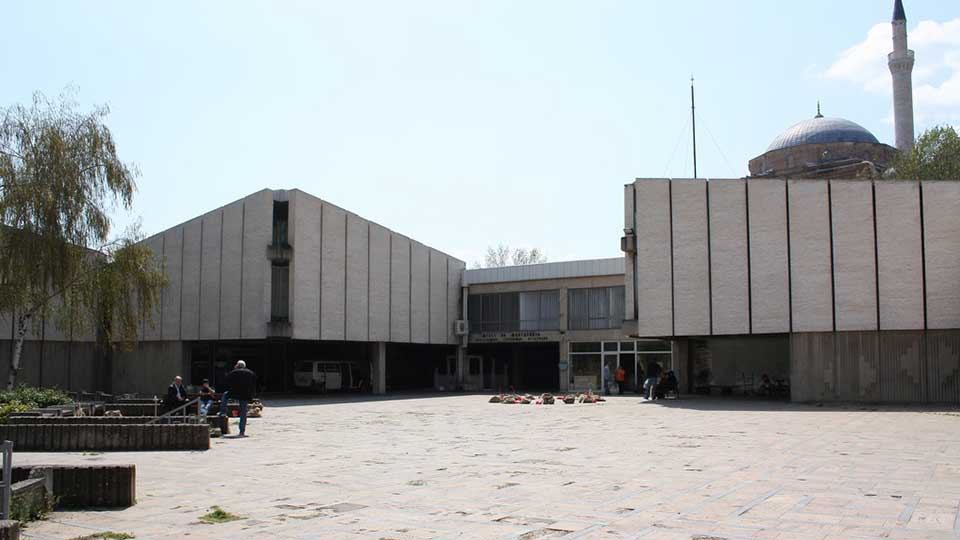
Museum of the City of Skopje - from the Neolithic to the present
The museum is housed in the adapted part of the Old Railway Station, destroyed in the 1963 earthquake. The relatively-preserved part of the building today is in function of the museum, which has a space of 4,500 m2, of which 2,000 m2 is exposing space. The museum owns a fund of about 22,000 museum objects from the Skopje region, distributed in segments of archaeology, history, ethnology and art history. "Walk through the past" is a permanent feature of the museum, which covers the period from the prehistory to the beginning of the 20th century for Skopje with its surroundings.

Museum of the Macedonian Struggle
It is located next to the Stone Bridge, on the left bank of Vardar. It was built in the period from 2008 to 2011, and officially opened on September 8, 2011. It consists of 13 units, in which chronologically presents the history of the Macedonian people from the period of the aidutstvo to the period of socialism. At the very entrance to the Museum, the original Macedonian Declaration of Independence is placed. The museum contains 109 wax figures of personalities from Macedonian history, a large number of samples of original weapons and furniture, mass scenes, documents.
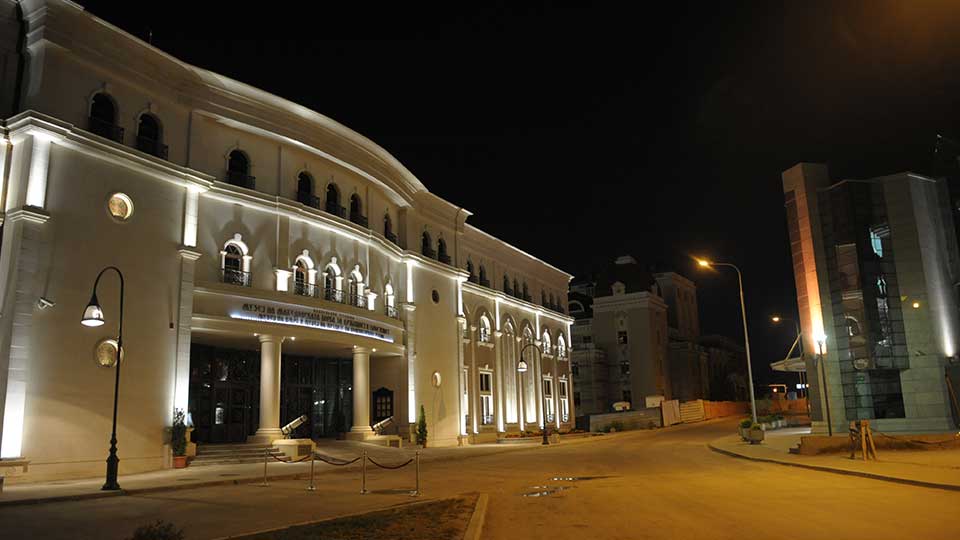
Memorial centre of the Holocaust of the Jews from Macedonia
The Holocaust Museum is a newly built facility on the site of the former Jewish neighbourhood, near the Stone Bridge, as one of the four such museums in the world, despite the museums in Jerusalem, Washington and Berlin. It is dedicated to Macedonian Jews (7,148 people) deported to the Treblinka death camp in Poland during the Second World War. There is a permanent exhibition of the life of the Jews in Macedonia and wider in the Balkans in this museum.
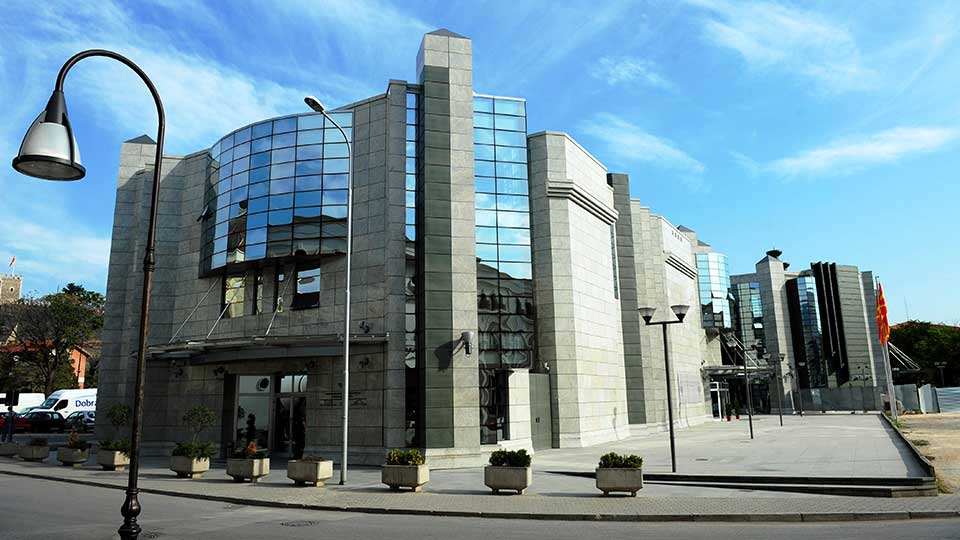
Museum of Contemporary Art in Skopje
The Museum of Contemporary Art is located in Skopje's Kale. It was built in 1970 as a donation from the Polish government, following the 1963 earthquake in Skopje. It covers an area of 5,000 m2 in three interconnected wings. They include the space for the permanent exhibition, temporary exhibition halls, lecture hall, film and video projections, library and archive, conservation workshop, depots, administration and other auxiliary services. It possesses a valuable international collection and provides a representative insight into the Macedonian contemporary art.
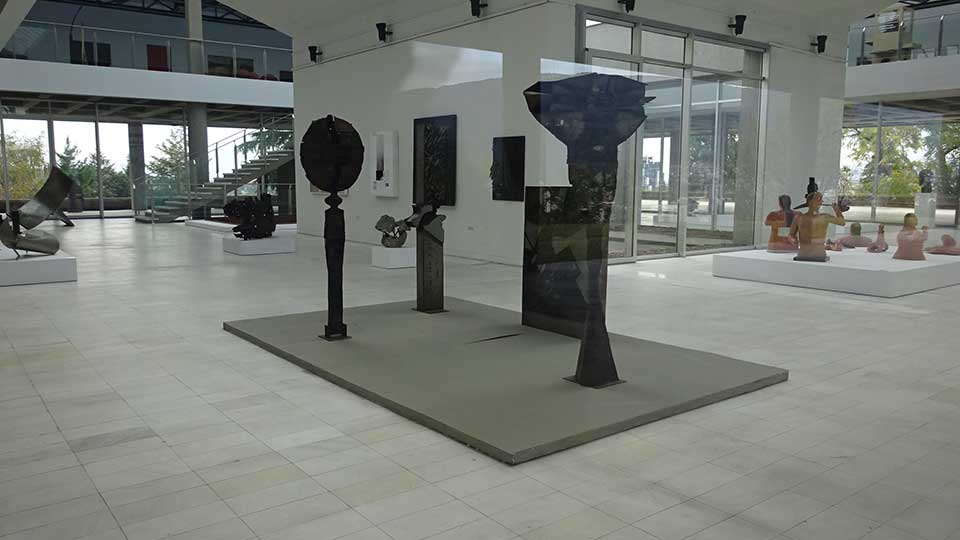
Vodno
Vodno is a mountain site that rises above Skopje to 1,061 metres above sea level. There is the Millennium Cross, the monastery Complex St. Pantelejmon, and Vodno also has a park - forest, mountaineering homes, several catering facilities with arranged hiking trails, car parks and wide panoramic views. From Vodno, you can see almost the entire Skopje valley and the city of Skopje. Therefore, Vodno is one of the most visited sites in the vicinity of Skopje.
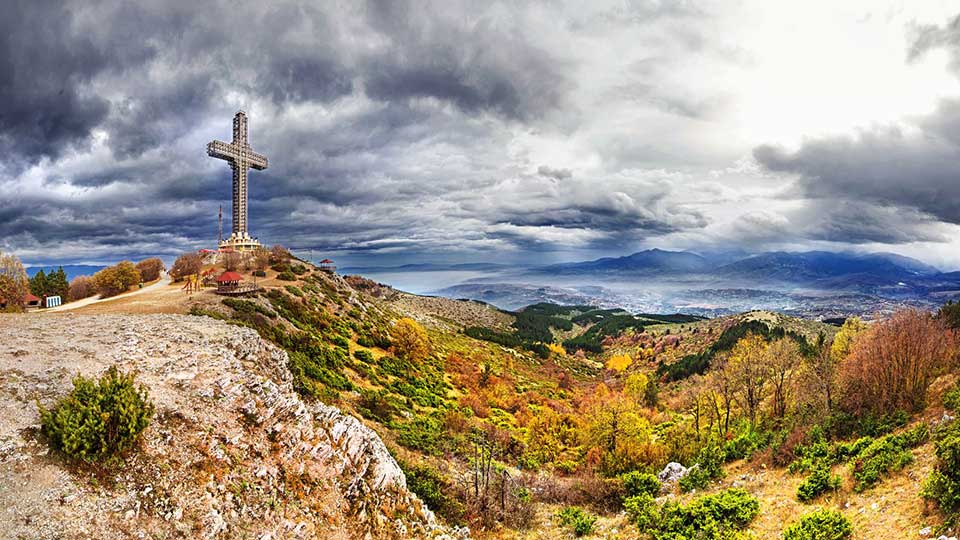
In June 2011, a cable car from Sredno Vodno to the Millennium Cross was put into operation, the alignment of which is 1,750 meters long and climbs from 570 to 1,068 metres above sea level. The cable car has 28 cabins with a load of 640 kg and capacity for eight people, as well as two cabins for four people. The gondolas on the outside are fitted with bicycle holders.
Millennium Cross
With a height of 66 metres this is the highest facility in Macedonia. The Millennium Cross was built in 2000 at the peak Krstovar (1,061 metres above sea level) in Vodno, in the immediate vicinity of Skopje, on the occasion of the passage of the second in the third millennium.
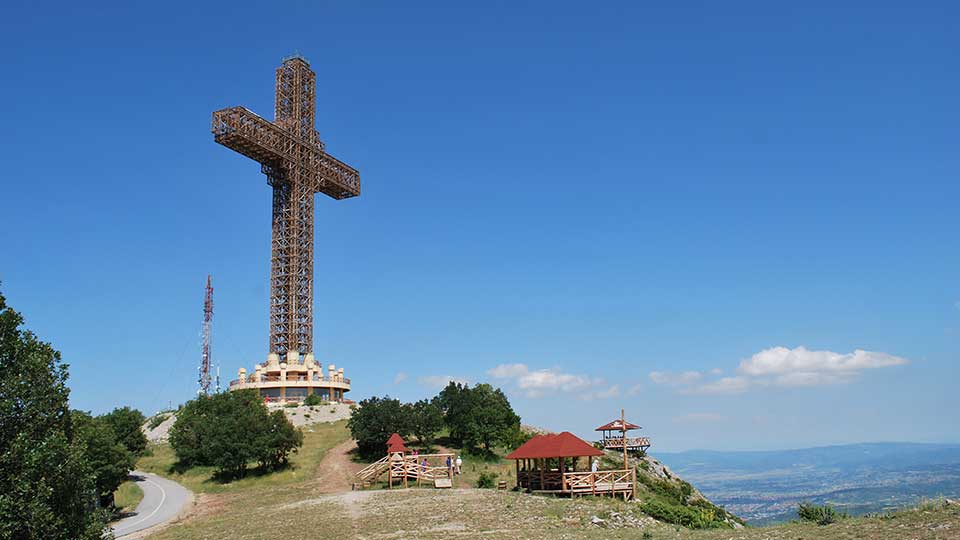
Monastery St. Pantelejmon, Gorno Nerezi (12th century)
This monastery possesses the most important fresco-paint value in Macedonia and one of the most valuable works of European church painting. In this monastery, the Renaissance in the fresco painting begins, almost a century and a half before the appearance of the renaissance in Italy of Giotto. The monastery was built in 1164, during the Byzantine Komnenos dynasty’s rule. This was written on the marble plate, placed above the front door. The best masters and painters of their time have done their best work. It was built with stone and brick, in the form of an inscribed cross in a rectangular space and five domes.
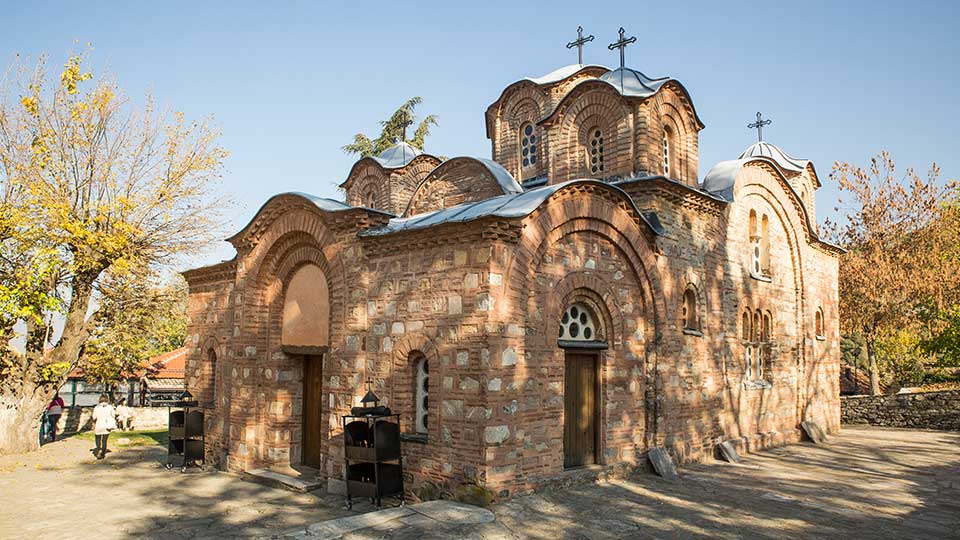
The monastery survived a fire, earthquake, ruin and robbery, but remained a witness to the rich church and cultural life in the 12th century and a church metropolitan centre in Skopje. This monastery is part of all the significant encyclopaedias for culture and art in the world. The 12th century frescoes represent the holy warriors and hermits (first zone), the great holidays (the second zone), and the most important are the frescoes of the Lamentation of Christ and the removal from the cross. The compositions of the Assumption of the Mother of God, The Sorrow, the Mother of God with Christ and Saint Panteleimon are also delightful.
Matka
It is the valley of the butterflies, it is a very characteristic locality in the immediate vicinity of Skopje. It is located northwest of Skopje, at the exit of the river Treska from the long Sishevska Ravine. Matka is a complex of deep, incised canyon, in which the first artificial accumulation on the Balkan Peninsula was built in 1938. There are several caves, an alpine training centre, a regulated flow of Treska for rafting, a complex of several monasteries, a mountain lodge, restaurants, catering facilities, a picturesque nature with rich vegetation and animal life. The accumulation itself covers an area of 0.25 km2. It is 5.9 km long, with a useful volume of 2.6 million m3. It is intended for the production of electricity in Skopje.
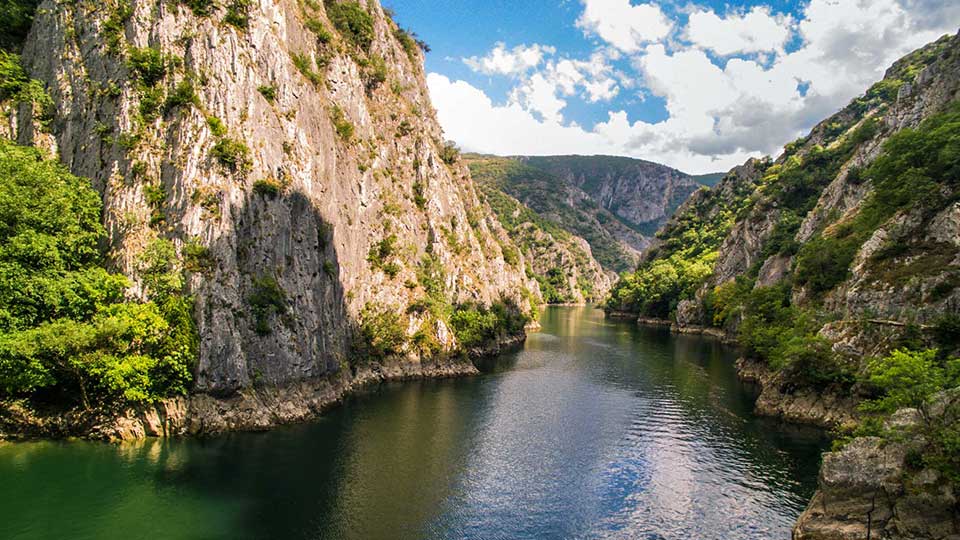
Monastery St. Andrej, Matka ( 1389 )
It was built on the canyon of the river Treska. It was built by Andreja, the second son of King Volkashin, in 1389. It has the form of an elongated trikonhos, with a central dome. Metropolitan Jovan and monk Gregorij, who worked in the monastery Sveto Preobrazenie in Zrze, are also fresco-painters of the monastery.
The frescoes in St. Andrej are a novelty in the Macedonian medieval painting and a mark of the new style at that time with the emergence of hesychasm in monastic life. In three zones, frescoes of the holy warriors Gjorgi, Dimitrij, Teodor, Tiron and Teodor Stratilat are presented in full size, as well as frescoes with scenes from the life of the Lord Jesus Christ. The inscriptions are written in Greek and in the Church Slavonic script.
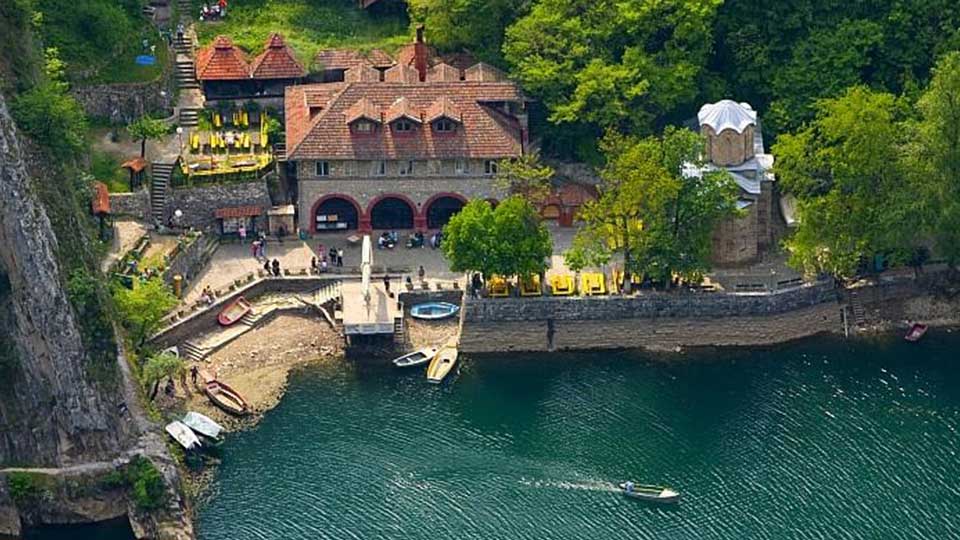
Neolithic village Tumba Madzari
The site is located in the current settlement of Chento and is the most important settlement in the Skopje valley from the Neolithic period - the early stone age. Life here existed continuously between 6000 and 4300 BC, economic prosperity and cultural prosperity in the Middle Neolithic (5800-500 BC). A number of ceramic findings, exhibited at the Museum of Macedonia, have been found here.
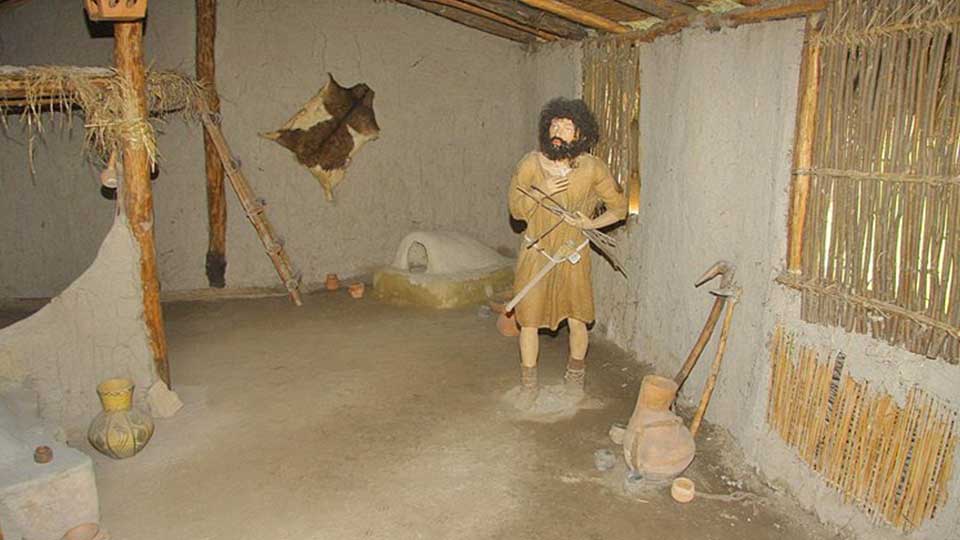
From 2008 to 2010, several houses were built in the spirit of Neolithic architecture, featuring a different inventory, in order to reconstruct the life of the Neolithic human. The houses are made of timber, cane, straw, clad with mud and built according to Neolithic traditions. The layout of the discovered objects on the site indicates a meaningful organization, closely related to the significance and role of the sanctuary.

The great mother - goddess of fertility
In Tumba Madzari, for the first time a terracotta presentation of the Great Mother was discovered, represented in an unknown way among the Neolithic cultures from other Balkan regions. The impressive dimensions of 39 centimetres height, a classical calm posture of vigilance over the house hearth, make this terracotta exquisite. The lower part of the figure represents the home protected by her. The Macedonian Neolith is characterized by a cult towards the Great Mother. Such types of figures are found in all Neolithic sites in Macedonia, but perhaps the most beautiful is the Great Mother of Tumba Madzari.
Skupi - a city of Roman and late-ancient times
Archaeological site, located five kilometres northwest of Skopje, in the immediate vicinity of the village of Zlokukani. Archaeological researches from 1966 to the present day are carried out by the Museum of the City of Skopje. So far, the walls, the theatre, the civil basilica, the city villa, the city bath, the cardo street, the Christian basilica, and parts of the eastern and western necropolis have been explored.
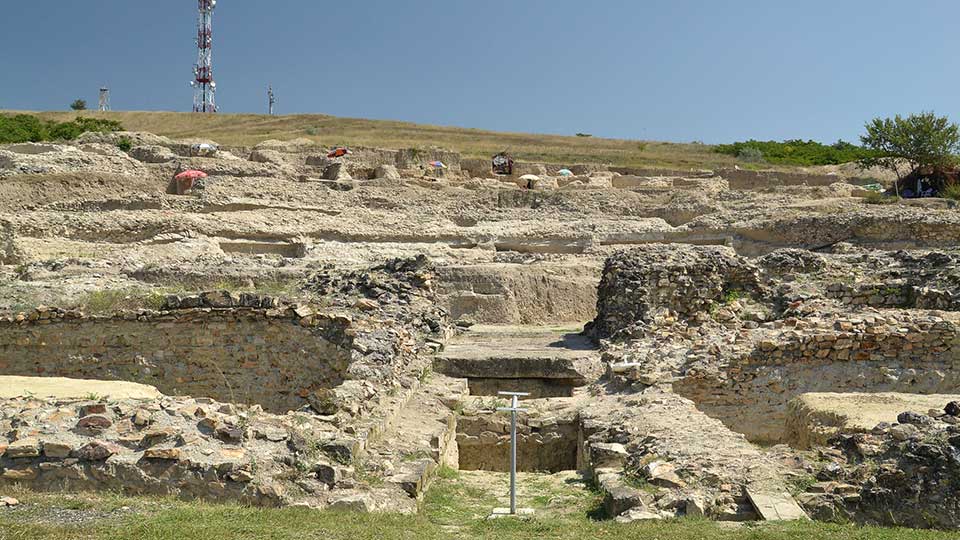
This Roman city was probably established in the period from the 12th to the 11th century BC. During the 2nd century Skupi received a representative character, with the monumental theatre occupying a central place. In 518, Skupi was demolished by a devastating earthquake, after which its urban life ceased, although there are indications that life in the form of a small Slavic rural settlement continued until the 10th and 11th century.
Aqueduct in SKopje
It is located two kilometres north of Skopje. It was built of stone and bricks and today it has 55 arcs leaning on massive columns. Although connected with Skupi, due to the similarity of the construction with Kursumli an, it is thought to have been built in the 15th century, when Skopje began to increase with the new Islamic buildings, for the construction and operation of which large quantities of pure water were needed. The quantity of water was constant and with guaranteed supply throughout the year.

Katlanovo Spa
The spa is located about 25 km from Skopje, in the vicinity of Katlanovo, on the right bank of the Pchinja River, at 230 metres above sea level. There are many sources. The main source is with 15l/sec. The water temperature is around 50 C. According to the chemical composition, the waters are alkaline, earth alkaline and sulfur hyperthermal. They are suitable for the treatment of the liver and gall bladder system, the nasal system of metabolism, abdominal bowel tract, heart-blood disease, and the like. The spa complex is equipped with tourist-catering and health facilities, with features for combined tourism types: healing, recreational, sports, fishing, hunting.
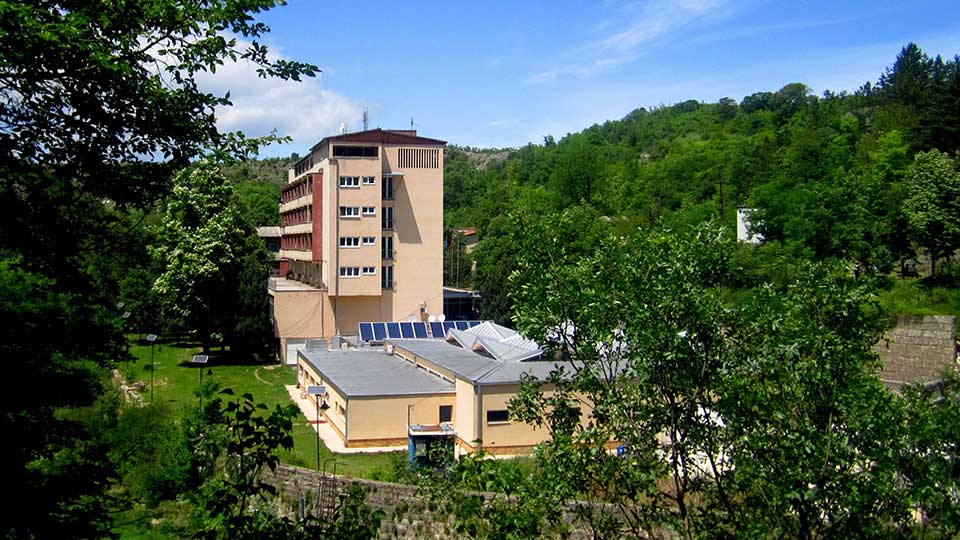
Marko’s monastery - St. Dimitrij, v. Sushica (14th century)
At about 20 km from Skopje, near Markova Reka in the vicinity of the village of Susica, there is Marko's monastery, named after the founders - King Vukashin and his son Marko. The data on the construction of the monastery church (1345) and the monastery's patrons are provided in the inscription of the south entrance, inside the church. The church is in the form of an inscribed cross, built of stone and brick. The frescoes are from the 14th century. These are rich illustrations from the Virgin Akathist, the miracles of Christ, the great feasts, and several individual figures of saints, angels, prophets, hermits and warriors. The most famous fresco of this monastery is the Lamentation of Rahil, where a heavy human drama presented through the killing of children in Bethlehem.
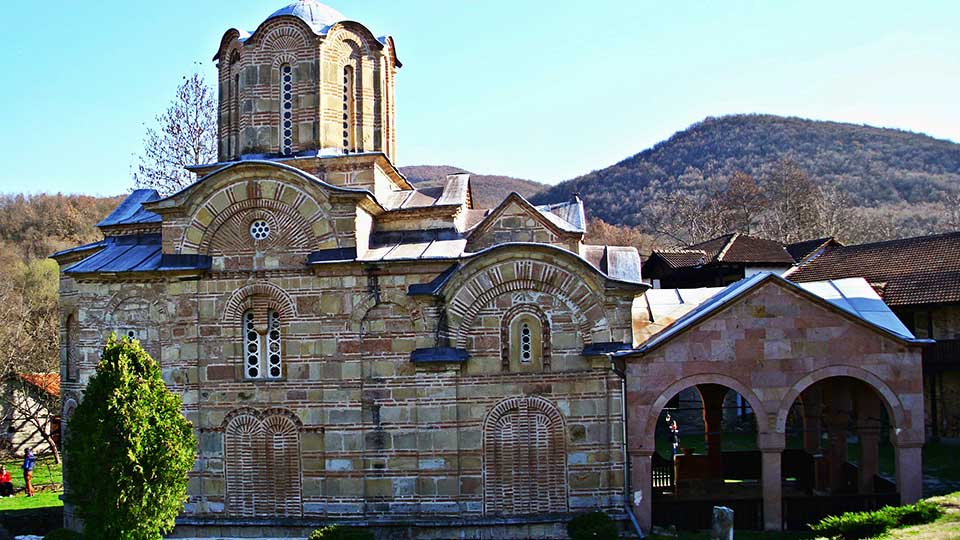
The monastery has a great church and cultural-historical treasure: icons, manuscripts and books, church objects and relics. An intense monastic life, copying and educational activity took place here. In the 19th century the abbot of the monastery was the Macedonian revivalist and writer Kiril Pejcinovic, who founded a school in the monastery, and here he also wrote his famous book Mirror.
Sports Centre Boris Trajkovski
The most complex sports facility in Macedonia. The larger hall has a capacity of 8,000 spectators for basketball competitions and 10,000 for concerts and other cultural events. It has a swimming pool, a hall for hockey, table tennis, a fitness room, a bowling alley, a sauna. The 2008 European Women Handball Championship was held here.
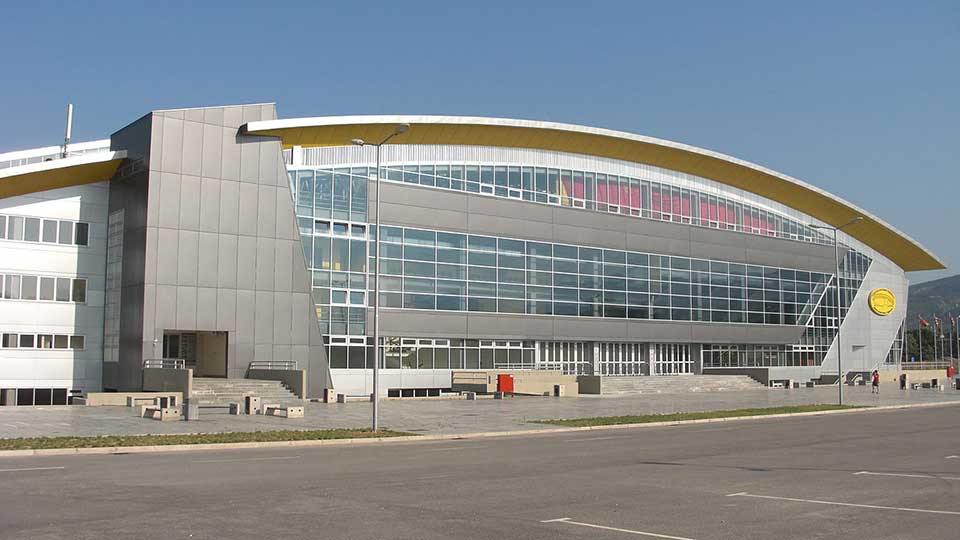
National Arena Philip II of Macedonia
A multi-purpose stadium, most commonly used for football competitions, with a maximum capacity of 36,400 spectators. It is used by the football clubs Rabotnicki and Vardar, as well as the football team of Macedonia. The construction of the City Stadium began in 1978 with the construction of the southern platform. In 2008, the old northern platform was demolished and a new one, according to the highest FIFA standards, was built. After the reconstruction of the south in 2011, the eastern and western platform were put into operation.
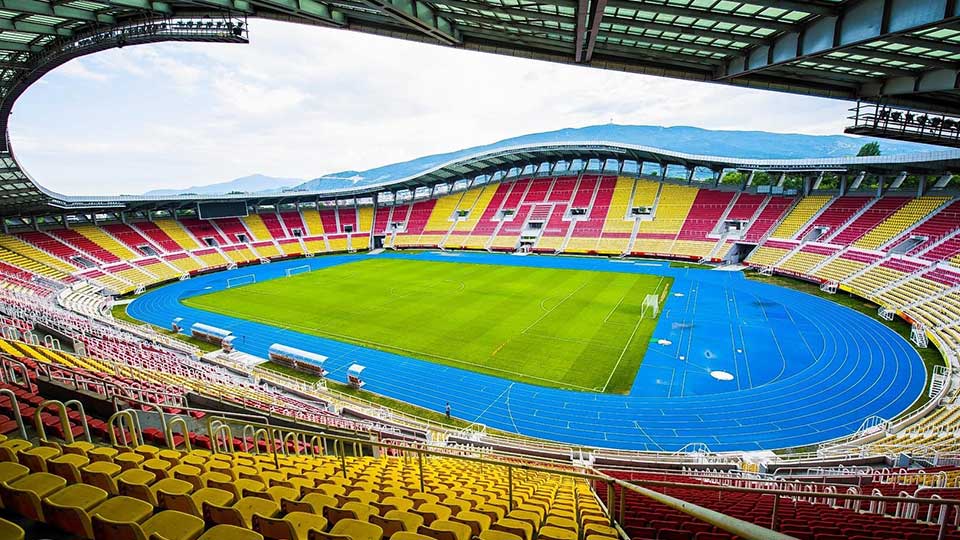
Manifestations
Skopsko Leto (21 June – 31 July, Skopje)
Since 1980, the conception of the manifestation includes music concerts, opera, ballet and drama performances, art and photo exhibitions, film programmes, performances and multimedia projects, as well as its own production and numerous visits from abroad. Open stages at the Skopje Fortress, the Old Bazaar, Kurshumli an, Vardar Quay, the City Park, the halls of the Skopje theatres and the art galleries pulsate at thirty different localities of Skopsko Leto.
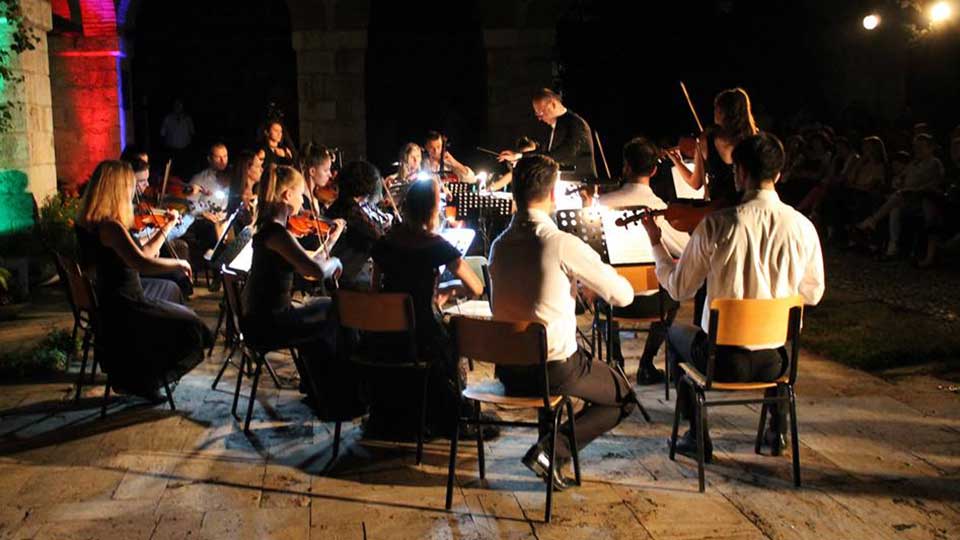
Majski Operski Veceri (May Opera Evenings) 9 – 31 May, Skopje
With a tradition since 1972, the festival is one of the most visited events in Skopje. The stage of the Macedonian Opera and Ballet is a host of the programme, which consists of opera performances, but also ballet, concert and symphonic performances. Regular participants at the May Opera Evenings are opera and ballet artists from the neighbouring countries and the world, as well as the ensembles of the Macedonian Opera and Ballet.
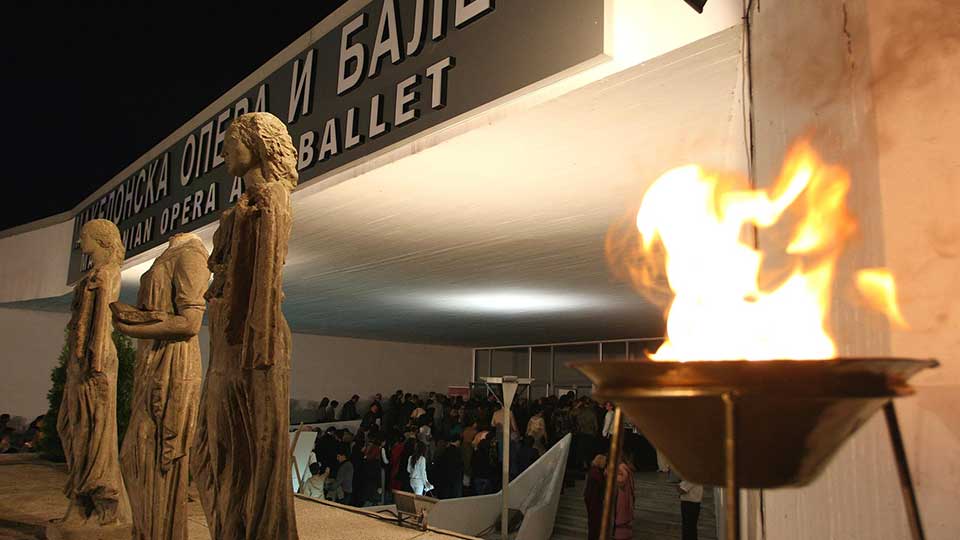
Baskerfest (May – June, Skopje)
International Street Artist Festival, held at several locations in Skopje. This is a free festival for the whole family, which does not charge tickets - the only price is a contribution put in the artists' hats. Spectacular carnival parade composed of numerous acrobats, clowns, comedians, stilt walkers, magicians, jugglers, breakers, puppeteers, caricaturists, pantomimists, national dancers, musicians, complemented by various masks, costumes and music.
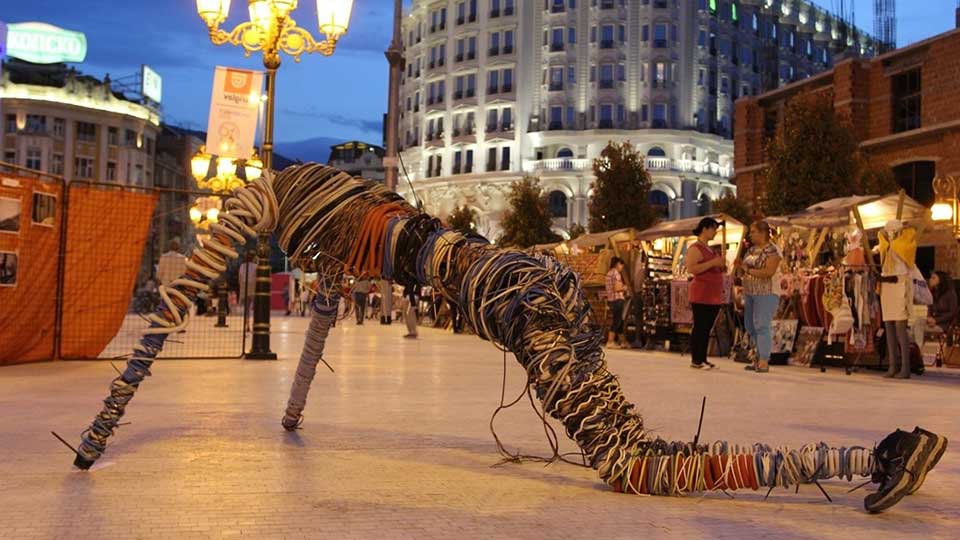
Pivolend in September
With about 300,000 visitors, the festival is the destination of quality entertainment and presentation of beer producers, accompanied by fantastic foods from local restaurants, animation of visitors with music.
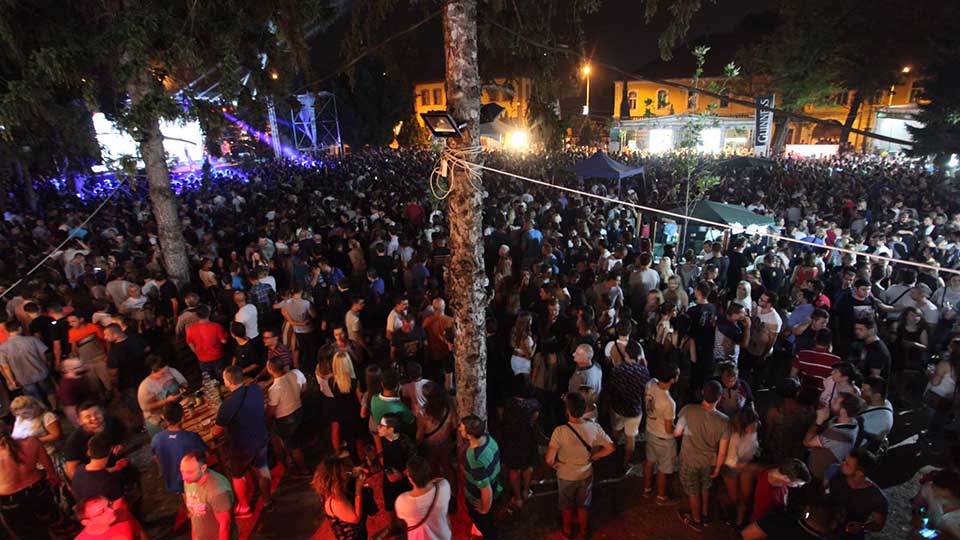
More information about Skopje can be found on this website.

